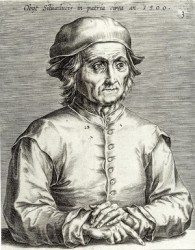
Waterschoot 1971
“Jeroen Bosch: middeleeuwse verhalen” (H. Waterschoot) 1971
[in: Jeugd en Cultuur, vol. XVI (1971), nr. 8/9, pp. 353-365]
[Not mentioned in Gibson 1983]
A lot of what has been published on Bosch was only based on assumptions and hypotheses. Bosch’s panels still clearly reflect the spirit of the Middle Ages, as opposed to – for example – the work of Da Vinci. That Bosch was not active in one of the artistic centres of his age does not mean that he is standing apart from the age in which he lived.
Bosch’s Last Judgment shows a lot of affinities with Giotto’s Last Judgment. Among the Flemish Primitives Bosch takes up a very special position: with him there is little idealization to be found. Two kinds of motif occur in his work: religious subjects and genre scenes. No detail in his panels is without meaning. Therefore his work is genrally approached in a rationalizing and analyzing rather than in an instinctive and reflective way. That the panels still hold out as paintings is caused by the exceptional artistic qualities of Bosch (beautiful colours, balanced compositions).
[explicit]